From vast sea lochs to heather-cloaked mountains, the Highlands and islands are some of the best places to see the unique wildlife in Scotland. We can't guarantee you'll see the most famous Scottish animal — Nessie doesn’t often surface for photos — but wildlife encounters are never far from the surface.
Where to see wildlife in Scotland
Scotland may be small, but the diversity of wildlife is anything but. Red squirrels scurry through Caledonian pine forests, golden eagles swoop over the Cairngorms, and red deer roam the dramatic glens of Glencoe. Look for mountain hares hopping across the Highlands, or watch playful otters frolicking in lochs and rivers. If you scan the waves in the Moray Firth, you may catch sight of bottlenose dolphins leaping through the water.
Best Scottish islands for wildlife
Many of the Scottish islands are home to an abundance of wildlife, though it varies by habitat. Around Shetland and Orkney, orcas occasionally patrol the coastline. Minke whales pass through deeper waters, and puffins crowd the cliffs in noisy colonies. The Hebrides have sea eagles and basking sharks offshore. Mull, Jura, and Arran are great for spotting otters, red deer, and golden eagles. Sail to remote islands and you’ll be nose to beak with thousands of gannets and guillemots in full screeching chorus.
When to see wildlife in Scotland
Spring kicks off the Scottish wildlife season, when migrating birds return and the clifftops are alive with activity. May and June are best for seeing puffins and other nesting seabirds. In summer, visitors often sight basking sharks off the west coast. Autumn is the season to listen for the roar of red deer during the rut and marvel at Atlantic salmon as they hurl themselves upriver during their annual migration. Winter is quieter, but grey seals come ashore to moult from December through April, and ptarmigan and mountain hares don their snowy coats to blend into the landscape.
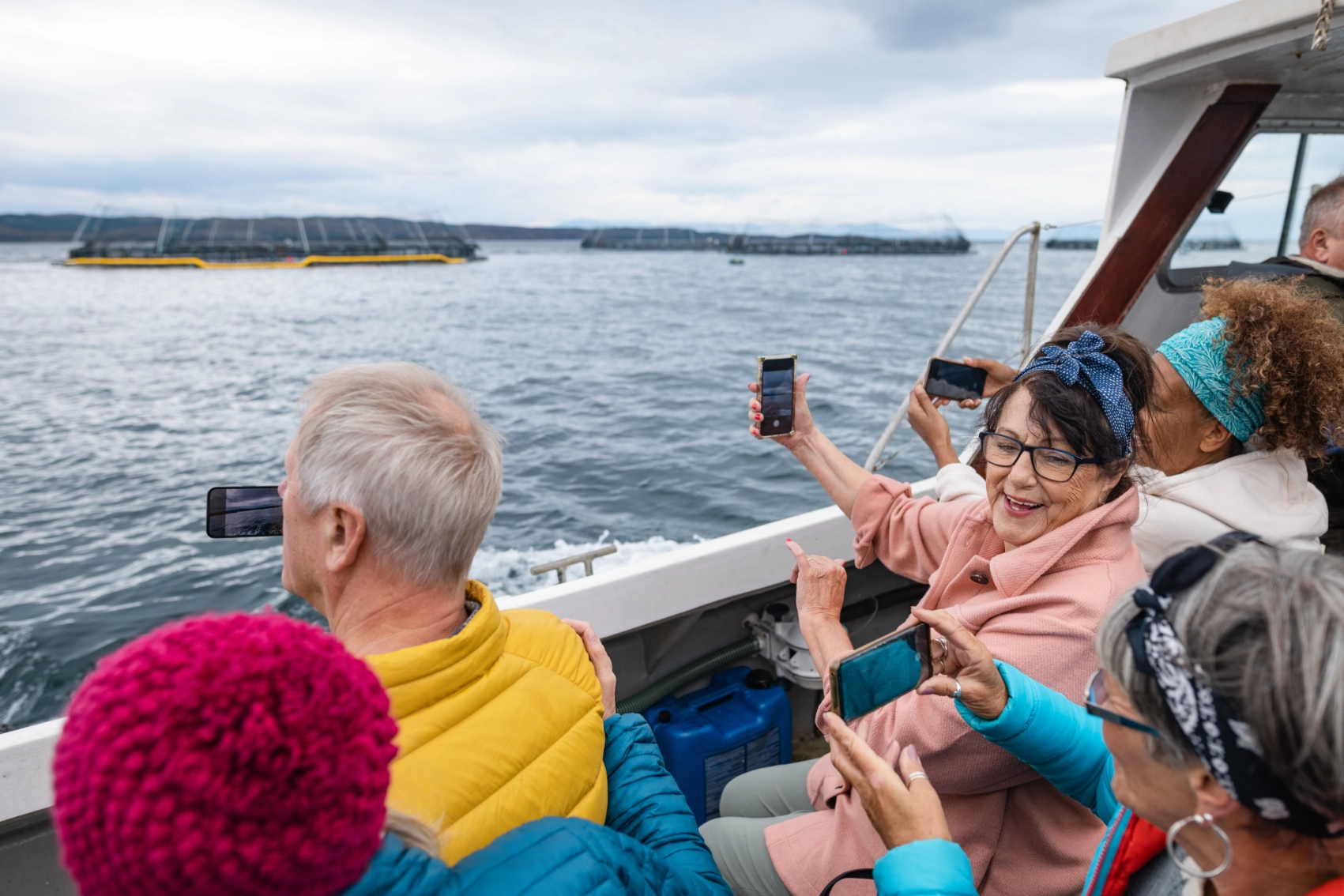
How to spot wildlife in Scotland
The country has many nature reserves and Scottish Wildlife Trust or RSPB sites, many of which have hides, marked trails, and species guides to help you identify what’s around. Binoculars are a must, and you should wear muted clothing and avoid strong scents that might put animals off. Keep your distance, especially near nesting sites or young. Never call out, chase, or try to get too close. Our expert expedition staff can advise you on when and where to look, offering tips on how to watch wildlife responsibly without causing disturbance, as well as how to photograph wildlife successfully.
What wild animals are in Scotland?
Scotland is home to a surprising mix of land, sea, and sky dwellers. Here's a look at some of the most iconic species you might spot on your travels.
Track orcas around the Orkney coast
These striking black and white predators are actually the largest members of the dolphin family. Orcas are highly intelligent, social, and seriously good hunters, feeding on seals, fish, and porpoises. In Scotland, they’re rare but thrilling summer visitors, mostly spotted gliding through the waves in small groups as you sail around the Orkney and Shetland coastlines. May to September is the best time of year to see orcas.
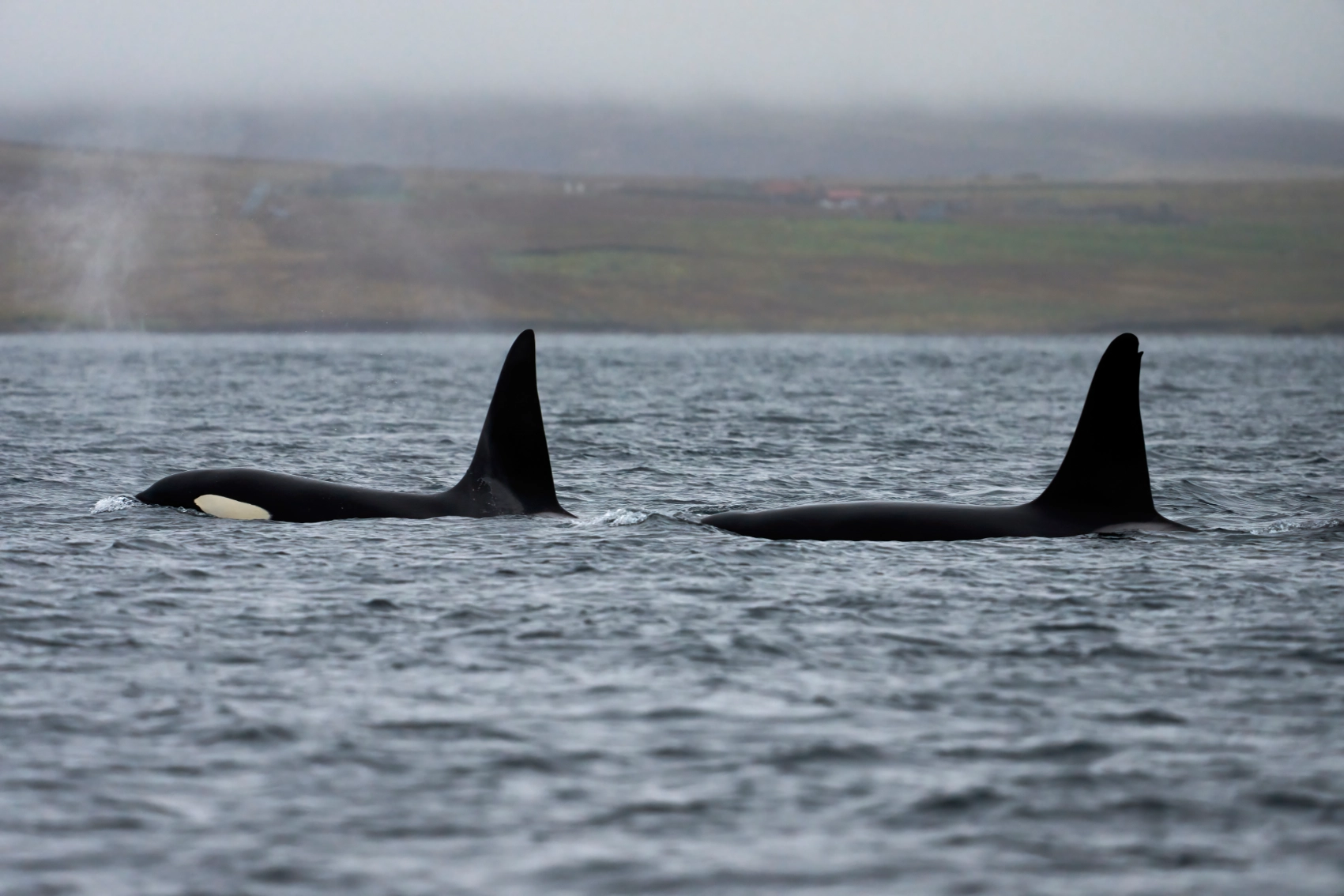
Watch minke whales feed around Eigg
Minke whales are most frequently seen in the waters around the Small Isles of Rum, Eigg, and Muck in summer. Their curious nature means they sometimes cruise close to boats. If you see a flock of seabirds circling above the waves, there’s a good chance that minke whales are below. They use a clever lunge-feeding technique for hunting, scooping up a mouthful of fish and seawater, and then straining it through their baleen like their own built-in colander.
Gaze at gentle basking sharks near Iona
Don’t be fooled by the size; this 8m-long (26 ft) giant is a plankton-slurping softie. Basking sharks glide through the ocean with their mouths wide open, filtering seawater like a slow-moving sieve. Despite their size, they’re harmless and fascinating to watch. Although they live in Scottish waters year-round, your best chance of spotting them is between June and September, especially around Iona and the Inner Hebrides, where they surface in calm waters where food is plentiful.
Join a pod party with bottlenose dolphins
The Moray Firth is home to about 200 resident bottlenose dolphins, the world’s most northerly resident pod. These energetic acrobats are often seen frolicking and flipping between April and August, and they thrive in this sheltered stretch of water. Watching these curious and sociable animals leap around is enough to bring a smile to your face, even if you encounter the worst of the Scottish weather.
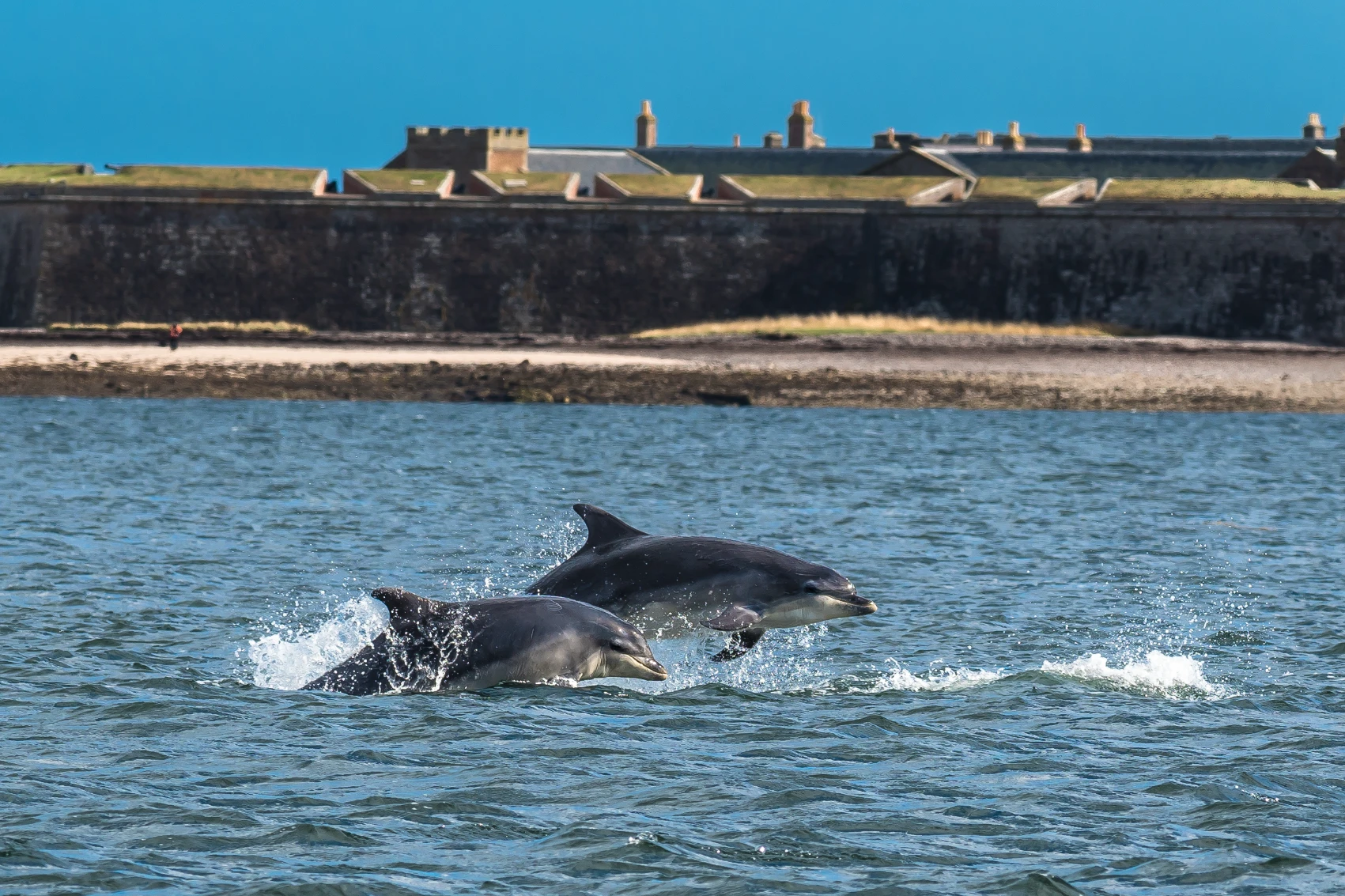
Splash out with common dolphins
Fast, flashy, and full of personality, common dolphins are usually seen in the Hebridean waters from May to September. These sleek swimmers can travel in pods of up to 50 dolphins, often surfacing in unison to the delight of those lucky enough to see them. These smaller cousins of the bottlenose can reach speeds of up to nearly 50km/h (32 mph) when chasing prey, and their distinctive hourglass markings make them easy to identify. Keep your eyes on the waves near Iona because they’re known to occasionally race alongside passing boats.
Hang out with grey seals in Shetland
The grey seal is the UK’s largest seal, and it's easy to spot with its long head and hooked nose. In Shetland, look for them lounging on rocky shores or bobbing in the bays around Lerwick or Hermaness National Nature Reserve. Hop on a Zodiac for the best views. If you're visiting between September and December, keep an eye out for the fluffy white pups. Born on land, they triple in size in just three weeks before heading out to sea on their own.
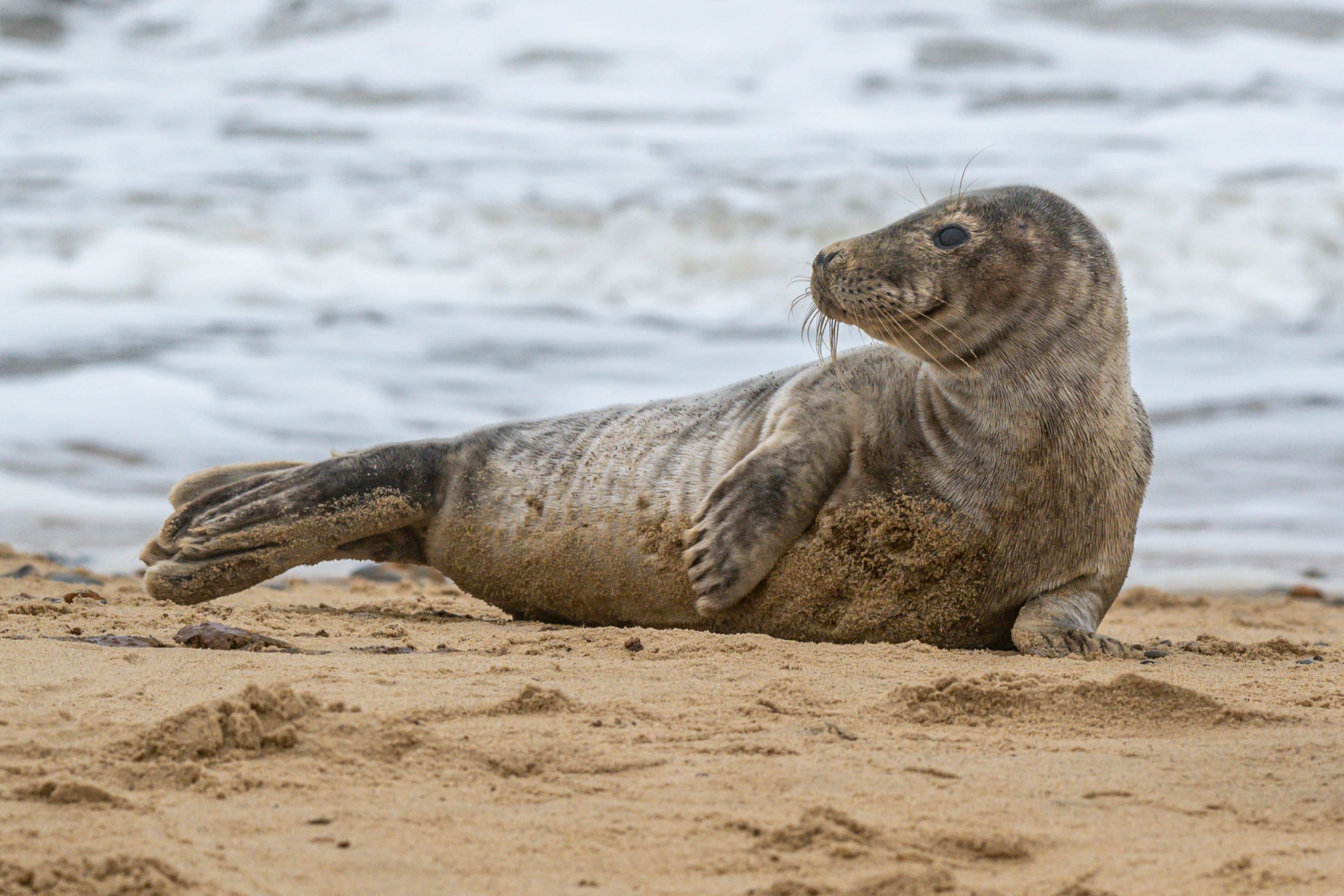
See them for yourself on: In the Wake of the Vikings: Orkney, Shetland & the Faroe Islands
Go common seal spotting at Mousa
Smaller and rounder than the grey seal, common seals favour sandy shores and sheltered estuaries. Unlike their fluffier cousins, pups are born ready to swim, often taking to the water within hours. They’re frequently spotted around Mousa in Shetland, especially in autumn, when an abundance of fish brings them close to shore. Look out for them lounging on sandbanks or popping up in quiet coastal inlets.
Watch gannets dive at St. Kilda
With a wingspan of up to 2m (6.5 ft) and a knack for high-speed dives, the northern gannet is Britain’s largest seabird and a spectacular sight. St. Kilda’s Stac Lee is home to one of the world’s largest gannet colonies, and from spring to summer, thousands soar overhead or plunge into the sea at speeds of up to 100 km/h (62 mph). Watch as they fly out from the cliffs of this giant sea stack to feed around the Hebridean Isles, often alongside dolphins.
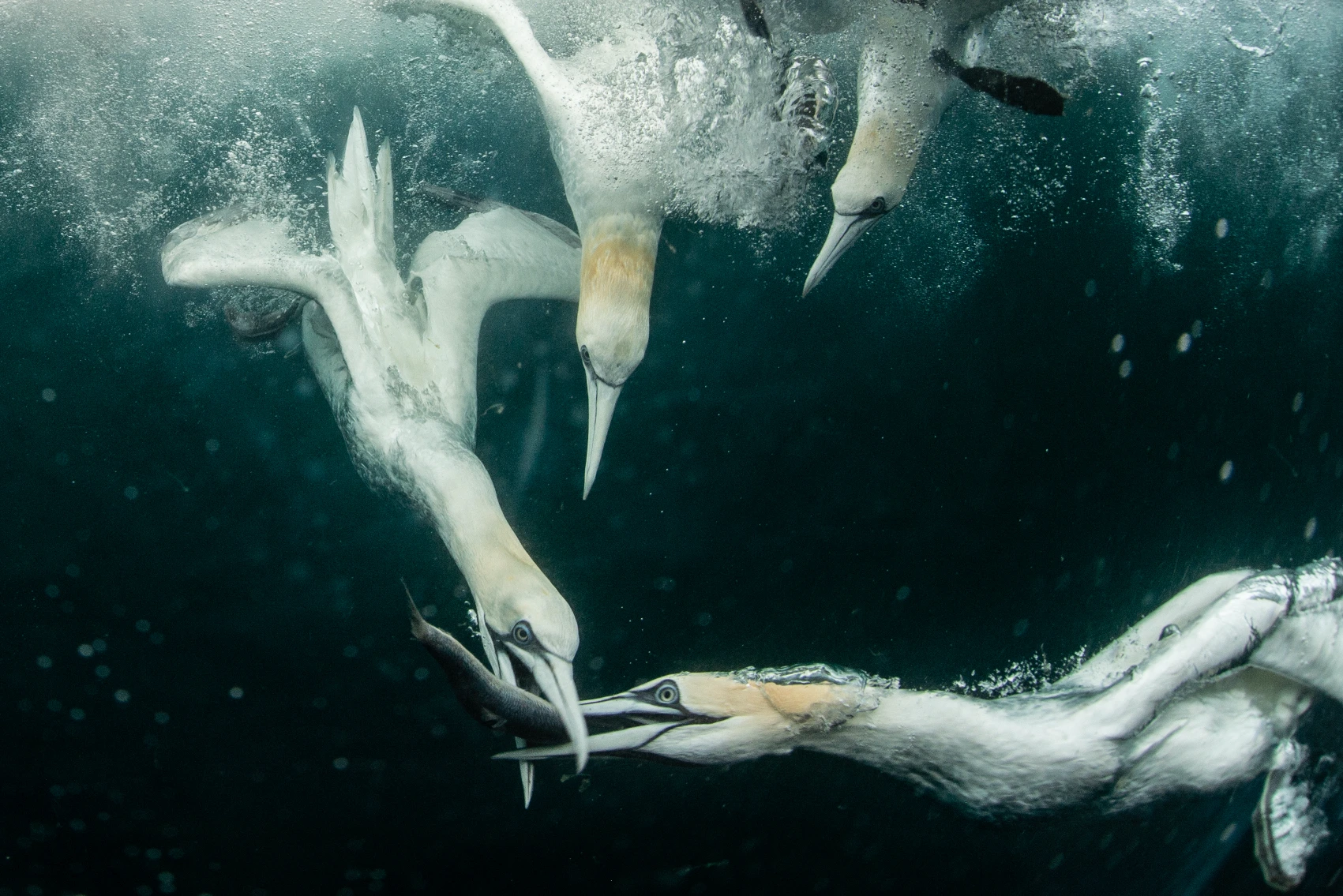
Scan the Highland skies for ospreys
The magnificent osprey is a skilled fish hunter found in reserves across the Highlands and Cairngorms. Once facing extinction in the UK, the population has slowly recovered thanks to decades of conservation work. With razor-sharp vision, it spots prey from above and then hovers before plunging feet first into the water. You stand a better chance of spotting them between April and August after their winter in West Africa. They are famously elusive, so patience is needed if you hope to see them in action.
Clown around in puffin territory
With black and white feathers, bright orange feet, and clown-like beaks, puffins are as photogenic as they are entertaining. If you want to know where to see puffins in Scotland, Lunga in the Treshnish Isles is one of the best places. During the breeding season from April to July, thousands nest in burrows on the grassy cliffs, diving for fish and using their wings like flippers underwater.
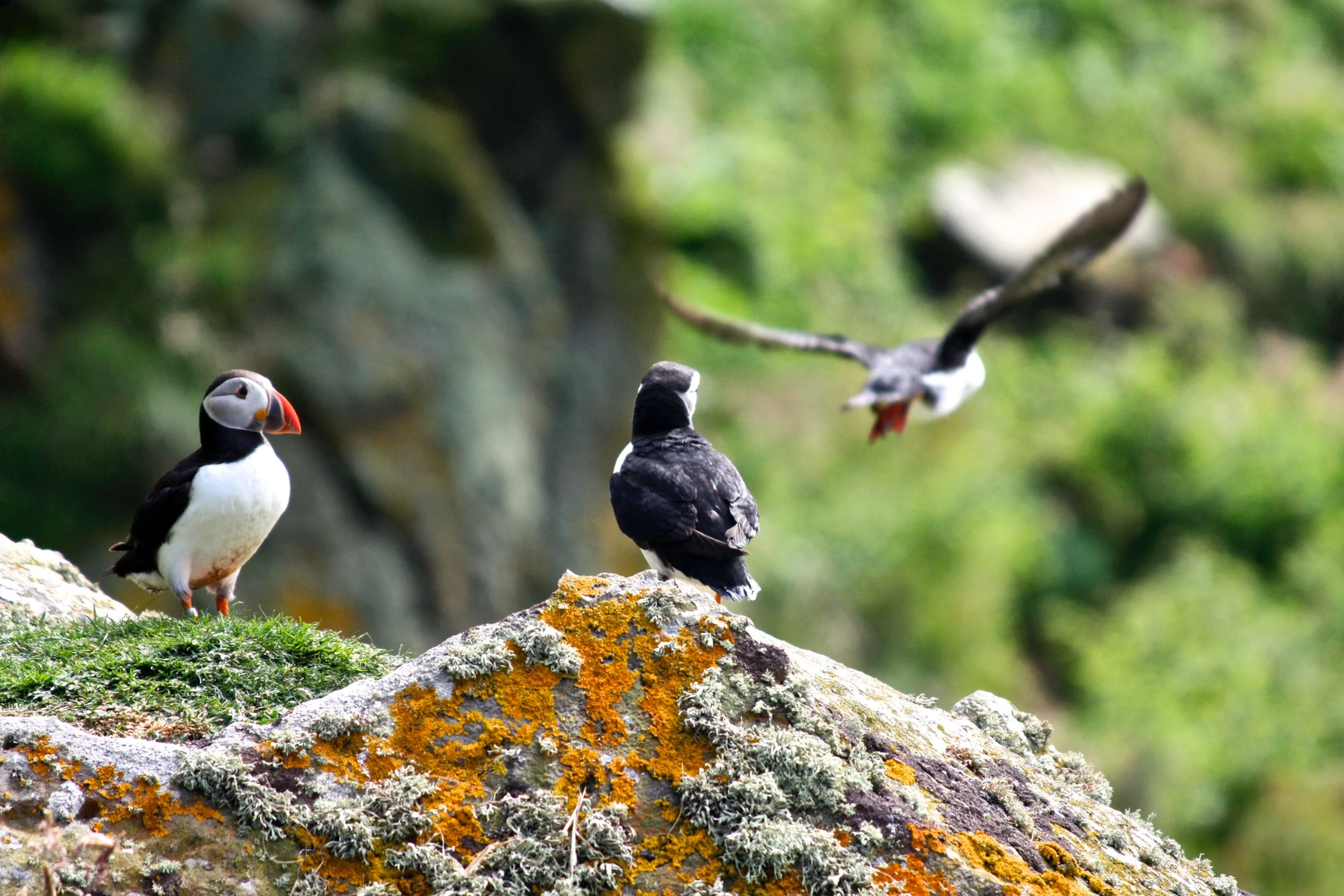
See them for yourself on: Expedition Through the Scottish Isles: Where Land Meets Legend
Look up for the majestic golden eagle
With a wingspan of more than 2m (6.5 ft), the golden eagle thrives in upland habitats, such as the Cairngorms National Park, where it hunts rabbits, grouse, and mountain hares. As you walk through the park, scan the ridgelines, and you may spot a golden eagle gliding high on thermal currents, searching the land below for its next meal.
Visit Scotland's west coast for sea eagles
The sea eagle, also called the white-tailed eagle, is the UK’s largest bird of prey, with a wingspan of up to 2.4m (7.8 ft). Hunted to extinction by 1918 but reintroduced in 1975, these giants now patrol the skies over remote coasts and inland lochs, particularly along the west coast of Scotland. Keep your eyes on the skies to see them gliding over the water as they hunt for fish or perch on clifftops surveying their kingdom.
Watch and wait for shy otters
Curious and playful but frustratingly shy, otters live along Scotland’s coasts, lochs, and rivers, but spotting one takes patience. You’ll often hear their high-pitched squeaks before you ever see one. They’re strong swimmers with webbed feet and muscular tails, and can close their ears, eyes, and nostrils underwater. Coastal otters need to eat more than 1kg (2.2 lbs) of fish and crustaceans each day, and they regularly rinse in freshwater to keep their dense insulating fur in top condition.
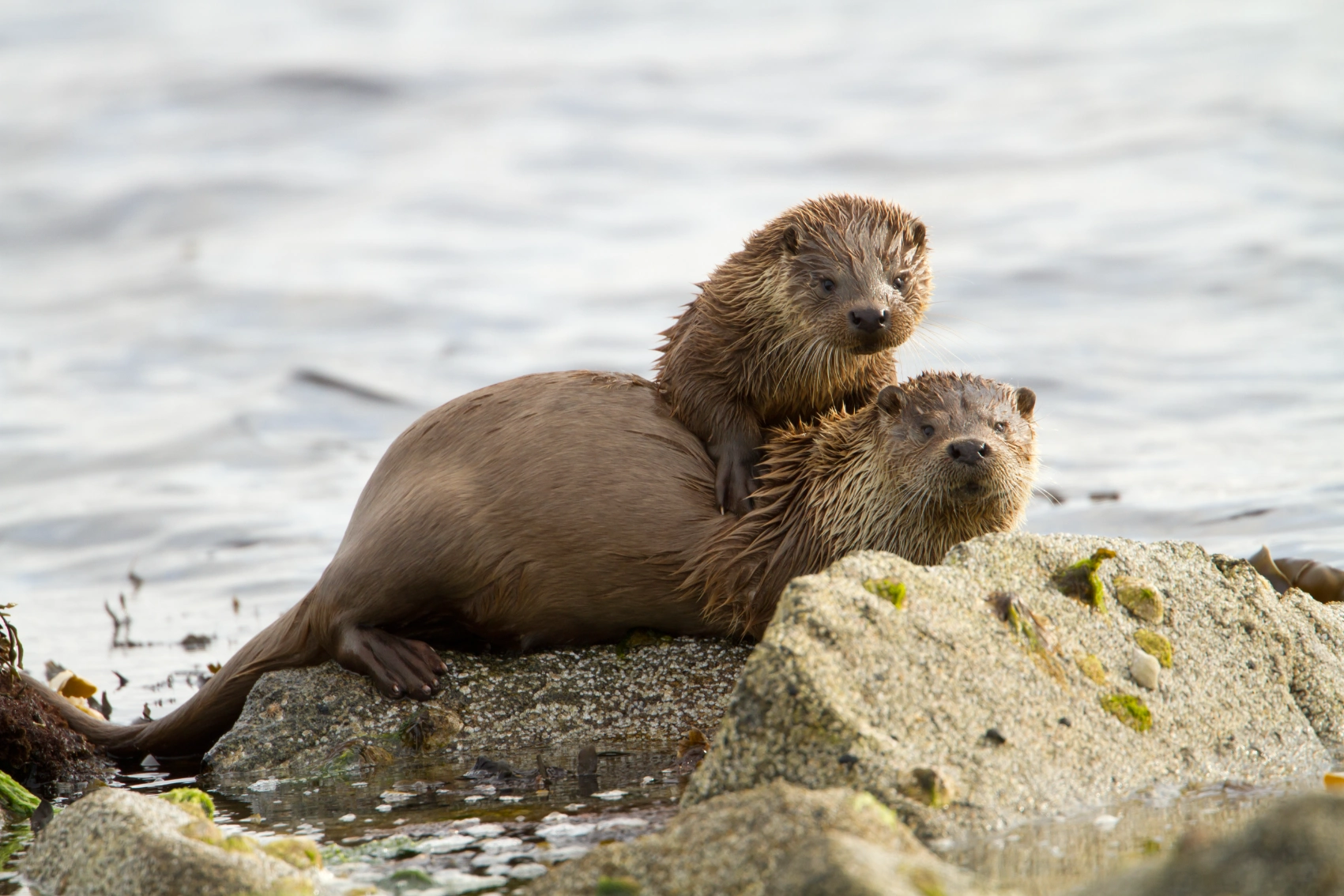
Track red deer at Glencoe
Big, bold, and proud, red deer are the largest land mammals in the UK and an icon of Scotland. You can see them gracing the label of a well-known whisky bottle or around Glencoe and the rest of the Highlands. Hear them bellow across the glens from September to November during the dramatic rutting season, or watch the awesome sight of stags clashing antlers as they fight to defend the females. With no natural predators remaining, red deer thrive in the open mountains and moorlands. Head out early or just before dusk for your best chance of seeing them.
See them for yourself on: Expedition Through the Scottish Isles: Where Land Meets Legend
Search the pine forests for red squirrels
With their distinctive russet coats and bushy tails, red squirrels are the original nut hoarders of Scotland’s forests and woodlands. Once under pressure from habitat loss and disease spread by invasive grey squirrels, their numbers are now stable in parts of Scotland thanks to conservation work. Active year-round, they stash hazelnuts and pine seeds to see them through the winter.
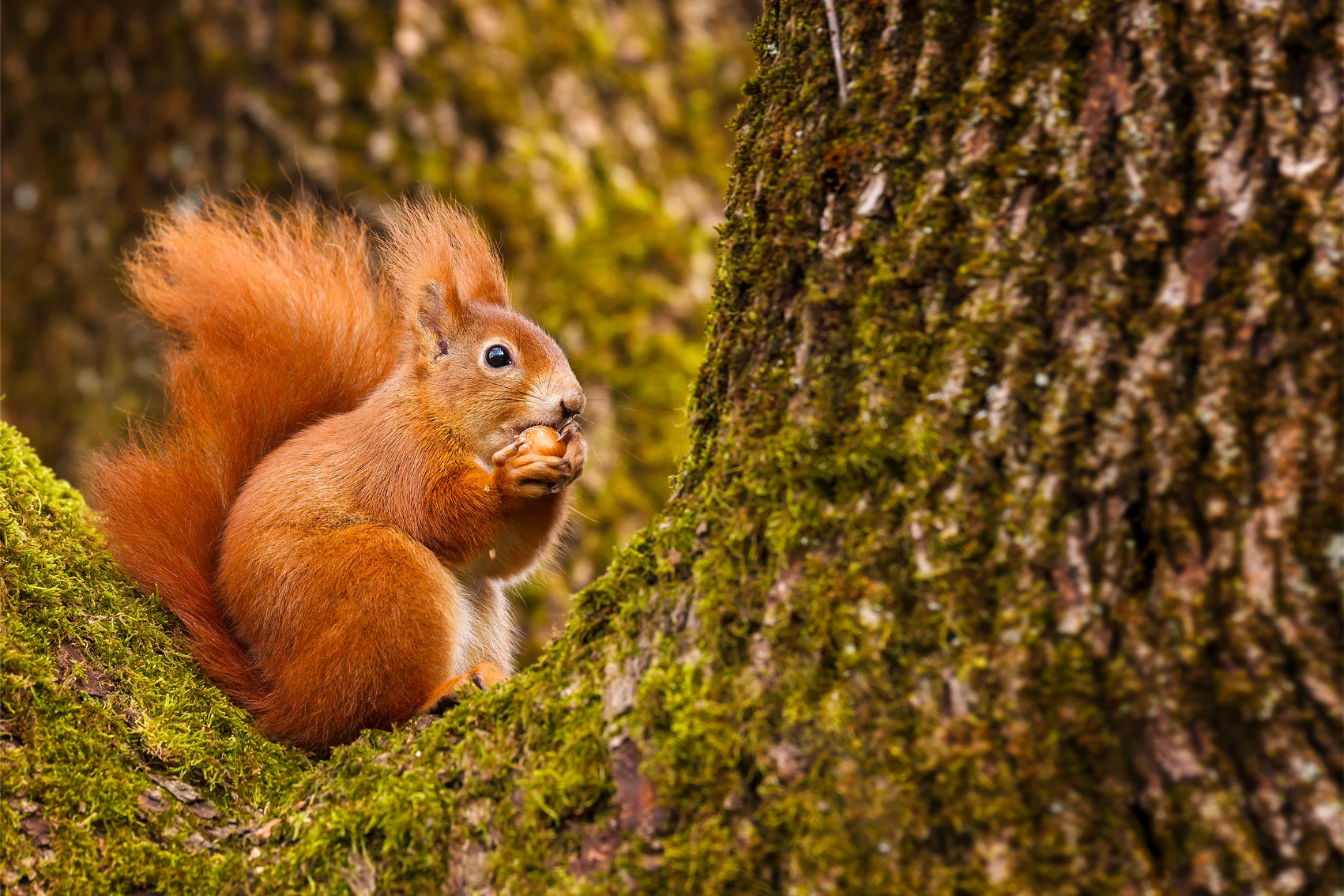
See them for yourself on: Highlights of Scotland
Track mountain hares in the Highlands
Masters of disguise, mountain hares change colour with the seasons. Their coats turn from grey-brown in summer to white in winter. Native to the Highlands, they’re easiest to spot in spring when the snow has gone, but their white fur remains. Look for them zigzagging across heather moorland on powerful hind legs. They feed on grasses and bark, and shelter in shallow scrapes in the ground called forms.
What's it like on a Scottish wildlife tour?
Expect to make the most of every moment on a G Adventures Scottish wildlife tour. Hike ancient glens, join expert-led walks, and sail around dramatic coastlines in a Zodiac while scanning the waves for whales, puffins, seals, and basking sharks. Sip whisky at local distilleries, hear legends from guides who know their seabirds from their selkies, and explore Viking ruins and standing stones. Every day brings changing landscapes, rich history, and close encounters with some of Scotland’s most iconic wildlife.
Do you need a guide to spot wildlife?
Having a guide is a huge benefit when spotting wildlife in Scotland. G Adventures' wildlife tours are led by experienced expedition staff who know about the habits and hiding spots of Scotland's wildlife. Their expertise makes the tours more enjoyable and informative, and helps you make the most of your surroundings. With their insights, you may even spot some endangered Scottish wildlife, such as ptarmigan, capercaillie, and beavers. If you pass by Loch Ness, keep your eyes peeled for a certain monster, too!























